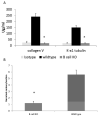An obligatory role for lung infiltrating B cells in the immunopathogenesis of obliterative airway disease induced by antibodies to MHC class I molecules
- PMID: 22233464
- PMCID: PMC3721353
- DOI: 10.1111/j.1600-6143.2011.03917.x
An obligatory role for lung infiltrating B cells in the immunopathogenesis of obliterative airway disease induced by antibodies to MHC class I molecules
Abstract
Using a murine model, we demonstrated that endobronchial administration of antibodies (Abs) to major histocompatibility complex (MHC) class I results in cellular infiltration, epithelial metaplasia, fibrosis and obstruction of the small airways (obliterative airway disease [OAD]) mediated predominantly by Th17 responses to self-antigens. This resembles bronchiolitis obliterans syndrome developed following human lung transplantation. Since B cells play a crucial role in induction of autoimmune responses, we defined the role of B cells and its antigen presenting properties in induction of OAD in this study. Anti-MHC class I was administered endobronchially in B(-/-) and wild-type mice. In contrast to wild type, B(-/-) animals did not demonstrate cellular infiltration, epithelial metaplasia and obstruction of airways following anti-MHC. Frequency of K-α1 tubulin and CollagenV-specific IL-17 cells was significantly decreased in B(-/-) mice. As expected, Abs against self-antigens and germinal center formation were not developed in B(-/-) mice. Thus, we conclude that B cells and its antigen presenting capacity play an important role in induction of immune responses to self-antigens and immunopathogenesis of OAD following the administration of anti-MHC. Therefore, strategies to block B-cell and its antigen presenting functions should be considered for preventing the development of chronic rejection.
© Copyright 2012 The American Society of Transplantation and the American Society of Transplant Surgeons.
Figures










Similar articles
-
B Cell-Activating Transcription Factor Plays a Critical Role in the Pathogenesis of Anti-Major Histocompatibility Complex-Induced Obliterative Airway Disease.Am J Transplant. 2016 Apr;16(4):1173-82. doi: 10.1111/ajt.13595. Epub 2016 Feb 4. Am J Transplant. 2016. PMID: 26844425 Free PMC article.
-
Critical role for IL-17A/F in the immunopathogenesis of obliterative airway disease induced by Anti-MHC I antibodies.Transplantation. 2013 Jan 27;95(2):293-300. doi: 10.1097/TP.0b013e3182772244. Transplantation. 2013. PMID: 23325004 Free PMC article.
-
Complement activation is not required for obliterative airway disease induced by antibodies to major histocompatibility complex class I: Implications for chronic lung rejection.J Heart Lung Transplant. 2012 Nov;31(11):1214-22. doi: 10.1016/j.healun.2012.08.011. Epub 2012 Sep 11. J Heart Lung Transplant. 2012. PMID: 22980951 Free PMC article.
-
Interplay between immune responses to HLA and non-HLA self-antigens in allograft rejection.Hum Immunol. 2013 Nov;74(11):1478-85. doi: 10.1016/j.humimm.2013.07.002. Epub 2013 Jul 19. Hum Immunol. 2013. PMID: 23876679 Free PMC article. Review.
-
Molecular mechanisms of chronic rejection following transplantation.Immunol Res. 2005;32(1-3):179-85. doi: 10.1385/IR:32:1-3:179. Immunol Res. 2005. PMID: 16106068 Review.
Cited by
-
Dysregulated MicroRNA Expression and Chronic Lung Allograft Rejection in Recipients With Antibodies to Donor HLA.Am J Transplant. 2015 Jul;15(7):1933-47. doi: 10.1111/ajt.13185. Epub 2015 Feb 3. Am J Transplant. 2015. PMID: 25649290 Free PMC article.
-
Extracellular Vesicles Mediate Immune Responses to Tissue-Associated Self-Antigens: Role in Solid Organ Transplantations.Front Immunol. 2022 Apr 27;13:861583. doi: 10.3389/fimmu.2022.861583. eCollection 2022. Front Immunol. 2022. PMID: 35572510 Free PMC article. Review.
-
Potential role of exosome-based allorecognition pathways involved in lung transplant rejection.J Thorac Cardiovasc Surg. 2021 Feb;161(2):e129-e134. doi: 10.1016/j.jtcvs.2020.04.183. Epub 2020 Jun 18. J Thorac Cardiovasc Surg. 2021. PMID: 33258452 Free PMC article.
-
Immune dysregulation as a driver of bronchiolitis obliterans.Front Immunol. 2024 Dec 17;15:1455009. doi: 10.3389/fimmu.2024.1455009. eCollection 2024. Front Immunol. 2024. PMID: 39742269 Free PMC article. Review.
-
Lung transplantation.F1000Prime Rep. 2013 May 1;5:16. doi: 10.12703/P5-16. Print 2013. F1000Prime Rep. 2013. PMID: 23710330 Free PMC article.
References
-
- Lange W. Uber eine eigenthumbiche erkankung der kleinen broncheim and bronchiolen. Deutsche Arch Klin Med. 1901;70:342–364.
-
- Sundaresan RS, Trulock EP, Mohanakumar T, Cooper JD, Patterson GA. Prevalence and outcome of bronchiolitis obliterans syndrome after lung transplantation. Washington University Lung Transplant Group. Annals of Thoracic Surgery. 1995;60:1341–1347. - PubMed
-
- Valentine VG, Robbins RC, Berry GJ, Patel HR, Reichenspurner H, Reitz BA, et al. Actuarial survival of heart-lung and bilateral sequential lung transplant recipients with obliterative bronchiolitis. J Heart Lung Transplant. 1996;15:371–383. - PubMed
-
- Smith MA, Sundaresan S, Mohanakumar T, Trulock EP, Lynch JP, Phelan DL, et al. Effect of development of antibodies to HLA and cytomegalovirus mismatch on lung transplantation survival and development of bronchiolitis obliterans syndrome. J Thorac Cardiovasc Surg. 1998;116(5):812–820. - PubMed
Publication types
MeSH terms
Substances
Grants and funding
LinkOut - more resources
Full Text Sources
Other Literature Sources
Research Materials

